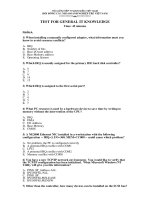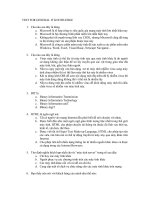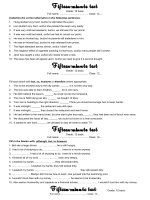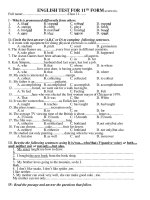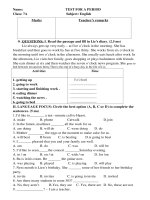revision test for Grammar
Bạn đang xem bản rút gọn của tài liệu. Xem và tải ngay bản đầy đủ của tài liệu tại đây (82.97 KB, 5 trang )
Revision tests
I/ True/ False:
1. In order to define open word classes, 3 types of criteria are used: form, function and
meaning.
2. For the closed classes, new members are being constantly added as new words are
coined in science, technology or by advertisers or sub-culture.
3. [s’] in Engineers’, students’ shows the genitive of noun.
4. Inflectional affixes create new words out of existing words or morphemes by their
addition.
5. Derivation affixes perform a grammatical function and are representatives of
grammatical categories.
6. The term morph is reserved for the unit of grammar and the term morpheme refers
to the morphological realization or manifestation of a morpheme.
7. The use of the adj behind linking verbs such as be, seem, appear indicates the
attributive unction of the adj.
8. The functional formula for a prepositional phrase is Head + Object.
9. The underlined part in “very enthusiastic about his latest idea” is obligatory.
10. The verb in “He still remained a teacher” is an intransitive verb.
11. The sentence John was in the park belongs to the sentence type of SVA.
12. An example of the sentence type SVOA is “He gave me expensive presents”
13. Every roots is a free morpheme
14. The coordinator and in the sentence “David is candid and Alice is secrete” implies
the relationship of contrast rather than addition.
15. The underlined adverbial phrase in “very carefully, she put him back on his feet
again” can not act as a Theme.
16. Ship in “relationship” is a free morpheme.
17. Typewrite is a word formed by back formation process.
18. [ s] in maps, [ z] in frogs and [ iz] in watches are allomorphs of a morpheme
meaning verb tenses.
19. Words are unanalyzable in grammar into smaller units called morphemes.
20. The relative order of morphemes in the English words is as follows: prefix
(derivational) – root – inflectional suffix – derivational suffixes.
21. The term morpheme is reserved for the unit of grammar and the term morph is used
to refer to the morphological realization or manifestation of a morpheme.
22. If a morpheme has more then one phonological realization it is said to have a
number of allophones.
23. The word PROFESSIONALIZED can be analyzed into the following morphemes:
PROFESS-ION-AL-IZE-(E)D.
24. Bound morphemes may stand alone as words in their own right as well as enter the
structure of other words.
25. In any word there appears to be one morpheme that is central (or the root) and one
or more others that are peripheral and are attached to the central morpheme or to
each other (or affixes).
26. Inflectional affixes perform a grammatical function and are representatives of
grammatical categories.
27. Derivational affixes create new words out of existing words or morphemes by their
addition.
28. RE- occurs in REPEAT, REPRODUCE, REDO, REFORM with the meaning
“again”.
29. Morphology is concerned with the way that words pattern, via phrase and clauses,
into sentences.
30. A verb is often defined as a word that typically inflects for plural number, functions
as head of a verb phrase, which typically function as subject or object of a clause.
31. For the open word classes the membership is fixed it is in general not impossible to
add new members.
32. The open word classes are: verbs, nouns, adjectives and adverbs.
33. The closed word classes are: nouns, pronouns, numerals, determiners, prepositions,
conjunctions.
34. Words can combine directly to form sentences.
35. NP, VP, ADjP take their names from the word that is the chief word or head of the
phrase but the PrepP and AdvP are different in that there is no head word in each.
36. The VP is composed potentially of there parts: the head, pre-modification, post-
modification.
37. Adverb phrases have two functions: attributive function and predicative function.
38. Adjective phrases have there functions in the adjunct position, in the conjunct
position, and in the disjunct position.
39. The clause contains modality, communicativity and propositional meaning.
40. The phrase contains modification, complementation, and sometimes coordination.
41. The five possible functions that phrases may fulfill in English clause structures are
S, V, O, C, and Adverbial.
42. The sentence “We are in good health” contains the structure: SVA.
43. The sentence “They asked for help from their allied countries” contains the
structure: SVOO.
44. The subject function is normally filled by NPs.
45. The object function may be sometimes filled by a PrepP, as for example in: Bill is
waiting for a big surprise.
46. On the table is an obligatory element in the sentence: The waiter put the soup on the
table.
47. Sentences may be coordinated by means of AND, BUT, OR or by means of YET,
SO.
48. In an ordinary active declarative clause, the Rheme is identical with the subject of
the cause (and the subject is an unmarked Theme).
49. In Peanuts I like, but crisps I can’t stand, the Rheme is a direct object.
50. The Theme of a clause is usually new information; it links with something that
occurs in the preceding text or context.
51. In the sentence: Go out quickly!, the performative verb is “order”.
52. Morphology is the study of the internal structure of words, and of the rules by
which words are formed.
53. The minimal meaningful units of language are morphemes.
54. Words are the smallest meaningful units of the Vietnamese language.
55. In order to identify morphemes, segmentation and classification are required.
56. Morphs and morphemes are interchangeably used.
57. Every allomorph is a morph.
58. Grammaticality of a sentence depends on the truth and the meaningfulness of that
sentence.
59. A root is not a morph.
60. Consequently in “Consequently, he passed his exam” is a disjunct.
61. Every root is a free morpheme.
62. Bound morphemes cannot occur alone while free morphemes can.
63. A base is a unit bigger than words.
64. Prefixes and suffixes are morphemes.
65. Word is the smallest unit of the language which occur on its own in speech and
writing.
66. The base in unbelievable is unbelieve.
67. “Wor-“ in worship is a morpheme.
68. “They wanted her to sing the song again” is a complex sentence.
69. F.D.I is an acronym.
70. “Flu” is the acronym of “influenza”.
71. Compounding is found in “prisoner-of-war”.
72. “Smog” is an abbreviation.
73. “Brunch” is a blending.
74. “Television” comes from “to televise”.
II./ MULTIPLE CHOICE:
1. Morphology is the study of ………………
A. pragmatics B. sentence C. morphemes & words D. utterances
2. ………… refers to the rules governing how added prefixes or suffixes can create
new words typically of a different part of speech.
A. Syntax B. Derivation C. Inflection D. Pragmatics
3. Impossibilities is an English word consisting of……… morphemes.
A, 2 B. 3 C. 4 D. 5
4. Research is a ………….morpheme.
A. Bound B. Derivation C. inflectional D. free
5. Which of the following is not the characterization of the English noun?
A. The possibility of occurrence with –ed, -s and –ing.
B. The possibility of occurrence with the possessive.
C. The possibility of occurrence with the plural.
D. The possibility of functioning as the subject of the sentence.
6. ………. …… can occur with –ed, -s, -ing.
A. nouns B. verbs C. adjectives D. prepositions
7. ………is a group of words which does not contain Subject- Predicate structure.
A. a clause B. a sentence C. a phrase D. none is correct.
8. Which of the following is not the feature of a sentence?
A. Predicativity B. modality C. communicativity D. non-concord.
9. The key in The key opened the door is a/an ………. Subject.
A. locative B. eventive C, instrumental D. temporal.
10. Which of the following id not an obligatory element in the sentence: He always
speaks English?
A. He B. always C. speaks D. English
11. He stays at home is a ……… sentence.
A. simple B. compound C. complex D. compound- complex
12. The sentence He read a book yesterday has the structure of ………….
A. SVOA B. SVC C. SV D. SOV
13. Which of the following is a complex word?
A. study B. amchair C. duty-free D. actor
14. Which of the following belongs to the open word class?
A. at B. because C. so D. rent
15. Hood in Childhood is …………
A. a free morpheme B a word C. a bound morpheme D. a prefix
16. In the sentence It is Green Ann likes, Green is …………
A. a structural subject B. a formal subject C. a logical subject D. the topic
17. Which of the following is not a function word?
A. if B. they C. at D. work
18. ……… is a grammatical category showing the relationship between the form of the
verb and the time of the action or state it describes.
A. tense B. case C. number D. mood
19. Which of the following word groups has the structure of the predication?
A. freedom or death B, sad movies C. be nice to her! D. he passed away
20. An information unit is usually a unit which contains………….
A. S+ Predicate B. given +new C. theme+ rheme D. NP+ VP
21. Which of the following is not the feature of a sentence?
A. communicativity B. modality C. predicativity D. productivity.
22. New York in New York is crowded is ……… subject.
A. agentive B. instrumental C. eventive D. personalized
III./ BLANK- FILLING.
1. The complete functional formula for the NP is …………… … +Head +Post +
Modifier.
2. Noun, Verb, Adj, Prep belong to the……………………….categories of ……….
……….
3. The complete functional formula of an AdjP is (Intensifier) + Head + ……………
……
4. ……………………….…clauses are clauses in which the predicate phrase begins
not with a present or past tense verb or a modal but a to before the verb.
5. The complete functional formula for adverb phrases is ……………….…… + head.
6. Pronouns bear the grammatical functions of ………………….……person, gender
and number.
7. A clause reflecting a process consists potentially of three components: process,
participants and……………….……….
8. In a sentence, the subject function is filled by a
………………………………….group.
9. In “Peter read the novel with great interest”, the adverbial function is realized by a
………………………phrase.
10. The functional formula for a verb phrase is (………………………….) + head +
(Objects/Complements) + (Modifier)
11. ………………… … are words derived from the initials of several words, e.g.
Nato, aids
12. The variant forms of a morpheme are called…………………
13. Morphemes that must be attached to another element are…………………
…… morphemes.
14. ……………………………is the study of word formation and the internal structure
of words.
15. The part of the grammar that concerns the structure of phrases and sentences
is……………
16. …………………………….…is a process by which a new word is created by
shortening a polysyllabic word as in ad, lab, exam, ect…
17. Words formed by combining parts of two already existing words as in motel,
brunch, are ……………………
18. A …………………………… is a group of words with its own subject and
predicate.
19. Given the clause organized as a message,…………………… is the element which
serves as the point of departure of the message.
20. The term “………………………categories” is used to refer to a class or group of
items which perform the same or similar functions in a language, e.g. case, person,
tense.
21. Morphemes that are added to another form and which do not change the syntactic
category of that form are called……………………….morphemes.
22. The process of deriving new words by assigning a new syntactic category to
existing words without using affixation is called…………………………………
23. Hi-tech (for high technology) is a word derived from the process of
…………………………… in word formation.
24. In terms of clauses as a message, …………………….…… is a element which
develops or predicates the focus of that message.
25. In the sentence “ She is a sensitive person”, sensitive shows
the………………………… function of adjectives.
26. Finally in “ Finally, he found a way to get out of the jungle” is a
………………… adverb.
27. Describing a sentence using patterns such as S + V + O.i + O.d has shown the
…………………………… characteristic of English sentences.
IV/ PROBLEM SOLVING:
1. Analyze the following words into their constituent morphemes, giving
a meaning to each morpheme:
1. PERSONALTIES 2. IRRESPONSIBLITIES 3. DEACIDFICATION
4. UNNECESSARILY 5. INTERDISCIPLEES 6. OVERSTRETCHED
7. RELATIONSHIPS 8. HUMOURISTS 9. UNDEREMPLOYED
10. UNGENTLEMANLINESS 11. INDUSTRIALISTS 12. REFORMERS
2. Identify the element(s) showing Theme, Rhme in the following
sentences:
1. Darling, would you cook dinner for me tonight?
2. It is yellow canaries that people have used to test the air of mining for
centuries.
3. How many kilometers can you walk a day?
4. Whatever you tell us will be of great help.
5. Unfortunately, however, he lost his partner.
6. It is Loan who sees the teacher first.
7. Loan, will you give me your hand?
8. Which little girls will wear those white costumes?
9. Consequently, nevertheless, he received help from his family.
10. How high can he jump?
11. It was Penny that Jim found last night in the casino.
12. The boy ate four apples.
3. Indicate the clause type (SV, SVO,…) each sentence belongs to:
1. I wouldn’t make rice in that saucepan.
2. They rolled the barrel into the courtyard.
4. Draw the tree diagrams for the following sentences:
1. He reads a book.
2. He sat on the chair.
3. The house on the hill collapsed in the strong wind.
4. The tall told American man put the book on Chomsky on the table.
5. She sang the song that won the first prize in 1990.
6. The teacher told me to open the drawer.
7. What film did you see last night.
8. The song that she sang won the first prize in 1990.
9. Would you like a cup of coffee?
10. I wanted you to call a taxi.
11. The man believed the rumor that his wife had taken the car.
12. They were happy that their children passed the exam.
13. She said that no one could meet her needs.
14. We work very hard to pass the exam.
15. She wrote the book that won the cultural award.
16. I wanted you to work harder.
